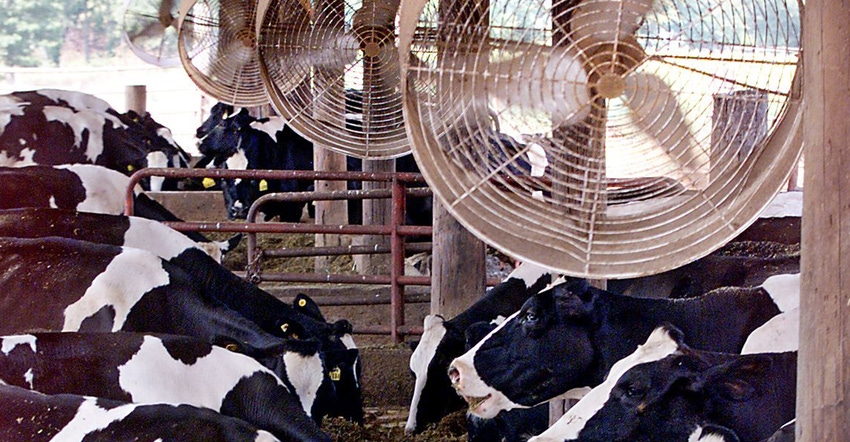July 18, 2019

As summer temperatures rise, dairy animals need to stay cool in order to remain productive.
Joe Zulovich, a University of Missouri Extension specialist in livestock housing systems, says farmers should look at ways to reduce the heat during the dog days of summer.
Lactating cows face the most risk from heat stress, he says, and need an abatement system. Heat reduction systems are economically beneficial for dairy operations in hot, humid climates.
Zulovich suggests five ways to make cows cooler and more productive:
1. Water. The best heat abatement available is an ample supply of fresh, clean drinking water, Zulovich says. The hotter it is, the more water cows need. Lactating cows consume 3 to 8 pounds of water per pound of dry matter intake. Larger dairy animals need about 2 feet of drinking space per animal. When temperatures soar, there should be enough space for 25% of the herd to drink at the same time. Water should be no more than 800 feet from the animals' resting area.
2. Shade. Protect animals from direct sunlight by providing buildings or roof systems. If these are not available, suspend shade cloth over holding pens, especially ones holding lactating cows. Also put shade cloth over feeding areas to keep feed fresh and prevent it from drying. Cows eat more and perform better if their feeding area is shaded. Pre-weaned calves rest better when their hutches have shade.
3. Ventilation. Ventilation exchanges air inside a building with outside air. The temperature inside shouldn't be more than 2 to 3 degrees higher than the outside temperature, Zulovich says. Air movement and direct evaporative cooling depend on good ventilation.
4. Air movement. Moving air helps move heat from the animal to the environment. Air should be moving at least 100 feet per minute over the animal's body for the best effect. Stirring fans, propeller fans or low-speed horizontal ceiling fans move the air inside buildings. In pasture-based systems, wind and shade can keep the herd cool.
5. Direct evaporative cooling. Every pound of water evaporated from a cow's skin surface dissipates about 1,000 BTUs of heat. Sprinklers create large droplets needed to reach the cow's hair coat and wet the skin surface. Air movement and good ventilation help to evaporate the water from the skin. Sprinklers with a 360-degree circular pattern work well in holding pens. Sprinklers with a 180-degree semicircular pattern work well next to and along feed bunks.
Run sprinklers about one minute — just enough to wet the cows. Shut off for five to 20 minutes to allow cows to dry and cool. Lactating cows need direct evaporative cooling when the other four strategies above do not reduce heat stress. Direct evaporative cooling is desirable for dry cows and replacement heifers within two months of calving.
While some pasture systems with irrigation systems let cows get wet under running irrigation sprinklers for direct evaporative cooling, Zulovich says it is typically not effective for dairy operations in Missouri and other humid climates.
Source: The University of Missouri Extension, which is solely responsible for the information provided and is wholly owned by the source. Informa Business Media and all its subsidiaries are not responsible for any of the content contained in this information asset.
You May Also Like




